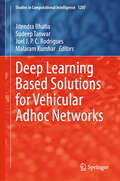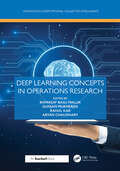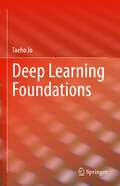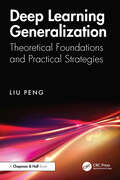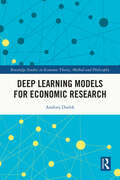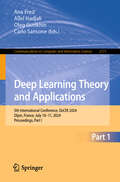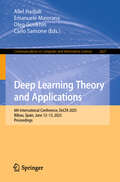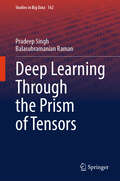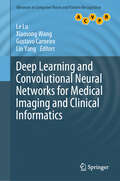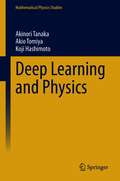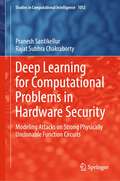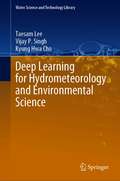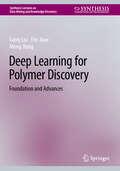- Table View
- List View
Deep Learning Applications in Operations Research (Advances in Computational Collective Intelligence)
by Gunjan Mukherjee Aryan Chaudhary Biswadip Basu Mallik Rahul KarThe model-based approach for carrying out the classification and identification of tasks has led to progression of the machine learning paradigm in diversified fields of technology. Deep Learning Applications in Operations Research presents the varied applications of this model-based approach. Apart from the classification process, the machine learning (ML) model has become effective enough to predict future trends of any sort of phenomenon. Such fields as object classification, speech recognition, and face detection have sought extensive applications of artificial intelligence (AI) and machine learning as well. The application of AI and ML has also become increasingly common in the domains of agriculture, health sectors, and insurance.Operations research is the branch of mathematics used to perform many operational tasks in other allied domains, and the book explains how the implementation of automated strategies in optimization and parameter selection can be carried out by AI and ML. Operations research has many beneficial aspects to aid in decision making. Arriving at the proper decision depends on a number of factors; this book examines how AI and ML can be used to model equations and define constraints to solve problems more easily and discover proper and valid solutions. This book also looks at how automation plays a significant role in minimizing human labor and thereby minimizes overall time and cost. Case studies examine how to streamline operations and unearth data to make better business decisions. The concepts presented in this book can bring about and guide unique research directions to the future application of AI-enabled technologies.
Deep Learning Applications, Volume 3 (Advances in Intelligent Systems and Computing #1395)
by Bhiksha Raj Dejing Dou M. Arif Wani Feng LuoThis book presents a compilation of extended version of selected papers from the 19th IEEE International Conference on Machine Learning and Applications (IEEE ICMLA 2020) and focuses on deep learning networks in applications such as pneumonia detection in chest X-ray images, object detection and classification, RGB and depth image fusion, NLP tasks, dimensionality estimation, time series forecasting, building electric power grid for controllable energy resources, guiding charities in maximizing donations, and robotic control in industrial environments. Novel ways of using convolutional neural networks, recurrent neural network, autoencoder, deep evidential active learning, deep rapid class augmentation techniques, BERT models, multi-task learning networks, model compression and acceleration techniques, and conditional Feature Augmented and Transformed GAN (cFAT-GAN) for the above applications are covered in this book. Readers will find insights to help them realize novel ways of using deep learning architectures and algorithms in real-world applications and contexts, making the book an essential reference guide for academic researchers, professionals, software engineers in the industry, and innovative product developers.
Deep Learning Applications, Volume 4 (Advances in Intelligent Systems and Computing #1434)
by Vasile Palade M. Arif WaniThis book presents a compilation of extended versions of selected papers from 20th IEEE International Conference on Machine Learning and Applications (IEEE ICMLA 2021). It focuses on deep learning networks and their applications in domains such as healthcare, security and threat detection, fault diagnosis and accident analysis, and robotic control in industrial environments. It highlights novel ways of using deep neural networks to solve real-world problems, and also offers insights into deep learning architectures and algorithms, making it an essential reference guide for academic researchers, professionals, software engineers in industry, and innovative product developers. The book is fourth in the series published since 2017.
Deep Learning Approach for Natural Language Processing, Speech, and Computer Vision: Techniques and Use Cases
by L. Ashok Kumar D. Karthika RenukaDeep Learning Approach for Natural Language Processing, Speech, and Computer Vision provides an overview of general deep learning methodology and its applications of natural language processing (NLP), speech, and computer vision tasks. It simplifies and presents the concepts of deep learning in a comprehensive manner, with suitable, full-fledged examples of deep learning models, with an aim to bridge the gap between the theoretical and the applications using case studies with code, experiments, and supporting analysis. Features: Covers latest developments in deep learning techniques as applied to audio analysis, computer vision, and natural language processing. Introduces contemporary applications of deep learning techniques as applied to audio, textual, and visual processing. Discovers deep learning frameworks and libraries for NLP, speech, and computer vision in Python. Gives insights into using the tools and libraries in Python for real-world applications. Provides easily accessible tutorials and real-world case studies with code to provide hands-on experience. This book is aimed at researchers and graduate students in computer engineering, image, speech, and text processing.
Deep Learning Architectures: A Mathematical Approach (Springer Series in the Data Sciences)
by Ovidiu CalinThis book describes how neural networks operate from the mathematical point of view. As a result, neural networks can be interpreted both as function universal approximators and information processors. The book bridges the gap between ideas and concepts of neural networks, which are used nowadays at an intuitive level, and the precise modern mathematical language, presenting the best practices of the former and enjoying the robustness and elegance of the latter.This book can be used in a graduate course in deep learning, with the first few parts being accessible to senior undergraduates. In addition, the book will be of wide interest to machine learning researchers who are interested in a theoretical understanding of the subject.
Deep Learning Based Solutions for Vehicular Adhoc Networks (Studies in Computational Intelligence #1207)
by Sudeep Tanwar Joel J. P. C. Rodrigues Jitendra Bhatia Malaram KumharThis book provides a holistic and comprehensive approach to deep learning for vehicular ad hoc networks (VANETs), covering various aspects such as applications, agency involvement, and potential ethical and legal issues. It begins with discussions on how the transportation system has been converted into Intelligent Transportation System (ITS). The use of VANETs is increasing in the development of ITS to enhance road safety, traffic efficiency, and driver comfort. However, the dynamic nature of vehicular environments and the high mobility of vehicles pose significant challenges to designing and implementing VANETs and ensuring reliable and efficient communication. Deep learning, a subset of machine learning, has the potential to revolutionize vehicular ad hoc networks (VANETs) to enable various applications such as traffic management, collision avoidance, and infotainment. DL has demonstrated great potential in addressing various challenges involved in VANETs by leveraging its ability to learn from vast data and make accurate predictions. It reviews the state-of-the-art DL-based approaches for various applications in VANETs, including routing, congestion control, autonomous driving, and security. In addition, this book provides a comprehensive analysis of these approaches' advantages and limitations and discusses their future research directions. The study in this book shows that DL-based techniques can significantly improve the performance and reliability of VANETs. Still, in-depth research is required to address the challenges of deploying these methods in real-world scenarios. Finally, the book discusses the potential of DL-based VANETs in supporting other emerging technologies, such as autonomous driving and smart cities. It explores the simulation/emulation tools for practical exposure to the vehicular ad hoc network.
Deep Learning Concepts in Operations Research (Advances in Computational Collective Intelligence)
by , Biswadip Basu MallikGunjan MukherjeeRahul KarAryan ChaudharyThe model-based approach for carrying out classification and identification of tasks has led to the pervading progress of the machine learning paradigm in diversified fields of technology. Deep Learning Concepts in Operations Research looks at the concepts that are the foundation of this model-based approach. Apart from the classification process, the machine learning (ML) model has become effective enough to predict future trends of any sort of phenomena. Such fields as object classification, speech recognition, and face detection have sought extensive application of artificial intelligence (AI) and ML as well. Among a variety of topics, the book examines: An overview of applications and computing devices Deep learning impacts in the field of AI Deep learning as state-of-the-art approach to AI Exploring deep learning architecture for cutting-edge AI solutions Operations research is the branch of mathematics for performing many operational tasks in other allied domains, and the book explains how the implementation of automated strategies in optimization and parameter selection can be carried out by AI and ML. Operations research has many beneficial aspects for decision making. Discussing how a proper decision depends on several factors, the book examines how AI and ML can be used to model equations and define constraints to solve problems and discover proper and valid solutions more easily. It also looks at how automation plays a significant role in minimizing human labor and thereby minimizes overall time and cost.
Deep Learning Cookbook: Practical Recipes to Get Started Quickly
by Douwe OsingaDeep learning doesn’t have to be intimidating. Until recently, this machine-learning method required years of study, but with frameworks such as Keras and Tensorflow, software engineers without a background in machine learning can quickly enter the field. With the recipes in this cookbook, you’ll learn how to solve deep-learning problems for classifying and generating text, images, and music.Each chapter consists of several recipes needed to complete a single project, such as training a music recommending system. Author Douwe Osinga also provides a chapter with half a dozen techniques to help you if you’re stuck. Examples are written in Python with code available on GitHub as a set of Python notebooks.You’ll learn how to:Create applications that will serve real usersUse word embeddings to calculate text similarityBuild a movie recommender system based on Wikipedia linksLearn how AIs see the world by visualizing their internal stateBuild a model to suggest emojis for pieces of textReuse pretrained networks to build an inverse image search serviceCompare how GANs, autoencoders and LSTMs generate iconsDetect music styles and index song collections
Deep Learning Foundations
by Taeho JoThis book provides a conceptual understanding of deep learning algorithms. The book consists of the four parts: foundations, deep machine learning, deep neural networks, and textual deep learning. The first part provides traditional supervised learning, traditional unsupervised learning, and ensemble learning, as the preparation for studying deep learning algorithms. The second part deals with modification of existing machine learning algorithms into deep learning algorithms. The book’s third part deals with deep neural networks, such as Multiple Perceptron, Recurrent Networks, Restricted Boltzmann Machine, and Convolutionary Neural Networks. The last part provides deep learning techniques that are specialized for text mining tasks. The book is relevant for researchers, academics, students, and professionals in machine learning.
Deep Learning Generalization: Theoretical Foundations and Practical Strategies
by Liu PengThis book provides a comprehensive exploration of generalization in deep learning, focusing on both theoretical foundations and practical strategies. It delves deeply into how machine learning models, particularly deep neural networks, achieve robust performance on unseen data. Key topics include balancing model complexity, addressing overfitting and underfitting, and understanding modern phenomena such as the double descent curve and implicit regularization.The book offers a holistic perspective by addressing the four critical components of model training: data, model architecture, objective functions, and optimization processes. It combines mathematical rigor with hands-on guidance, introducing practical implementation techniques using PyTorch to bridge the gap between theory and real-world applications. For instance, the book highlights how regularized deep learning models not only achieve better predictive performance but also assume a more compact and efficient parameter space. Structured to accommodate a progressive learning curve, the content spans foundational concepts like statistical learning theory to advanced topics like Neural Tangent Kernels and overparameterization paradoxes.By synthesizing classical and modern views of generalization, the book equips readers to develop a nuanced understanding of key concepts while mastering practical applications.For academics, the book serves as a definitive resource to solidify theoretical knowledge and explore cutting-edge research directions. For industry professionals, it provides actionable insights to enhance model performance systematically. Whether you're a beginner seeking foundational understanding or a practitioner exploring advanced methodologies, this book offers an indispensable guide to achieving robust generalization in deep learning.
Deep Learning Models for Economic Research (Routledge Studies in Economic Theory, Method and Philosophy)
by Andrzej DudekIn today’s data-driven world, the ability to make sense of complex, high-dimensional datasets is crucial for economists and data scientists. Traditional quantitative methods, while powerful, often struggle to keep up with the complexities of modern economic challenges. This book bridges this gap, integrating cutting-edge machine learning techniques with established economic analysis to provide new, more accurate insights.The book offers a comprehensive approach to understanding and applying neural networks and deep learning models in the context of conducting economic research. It starts by laying the groundwork with essential quantitative methods such as cluster analysis, regression, and factor analysis, then demonstrates how these can be enhanced with deep learning techniques like recurrent neural networks (RNNs), convolutional neural networks (CNNs), and transformers. By guiding readers through real-world examples, complete with Python code and access to datasets, it showcases the practical benefits of neural networks in solving complex economic problems, such as fraud detection, sentiment analysis, stock price forecasting, and inflation factor analysis. Importantly, the book also addresses critical concerns about the “black box” nature of deep learning, offering interpretability techniques like Local Interpretable Model-agnostic Explanations (LIME) and SHapley Additive exPlanations (SHAP) to demystify model predictions.The book is essential reading for economists, data scientists, and professionals looking to deepen their understanding of AI’s role in economic modeling. It is also an accessible resource for non-experts interested in how machine learning is transforming economic analysis.
Deep Learning Technologies for the Sustainable Development Goals: Issues and Solutions in the Post-COVID Era (Advanced Technologies and Societal Change)
by T. P. Singh Virender Kadyan Chidiebere UgwuThis book provides insights into deep learning techniques that impact the implementation strategies toward achieving the Sustainable Development Goals (SDGs) laid down by the United Nations for its 2030 agenda, elaborating on the promises, limits, and the new challenges. It also covers the challenges, hurdles, and opportunities in various applications of deep learning for the SDGs. A comprehensive survey on the major applications and research, based on deep learning techniques focused on SDGs through speech and image processing, IoT, security, AR-VR, formal methods, and blockchain, is a feature of this book. In particular, there is a need to extend research into deep learning and its broader application to many sectors and to assess its impact on achieving the SDGs. The chapters in this book help in finding the use of deep learning across all sections of SDGs. The rapid development of deep learning needs to be supported by the organizational insight and oversight necessary for AI-based technologies in general; hence, this book presents and discusses the implications of how deep learning enables the delivery agenda for sustainable development.
Deep Learning Theory and Applications: 5th International Conference, DeLTA 2024, Dijon, France, July 10–11, 2024, Proceedings, Part I (Communications in Computer and Information Science #2171)
by Ana Fred Oleg Gusikhin Carlo Sansone Allel HadjaliThe two-volume set CCIS 2171 and 2172 constitutes the refereed best papers from the 5th International Conference on Deep Learning Theory and Applications, DeLTA 2024, which took place in Dijon, France, during July 10-11, 2024. The 44 papers included in these proceedings were carefully reviewed and selected from a total of 70 submissions. They focus on topics such as deep learning and big data analytics; machine-learning and artificial intelligence, etc.
Deep Learning Theory and Applications: 5th International Conference, DeLTA 2024, Dijon, France, July 10–11, 2024, Proceedings, Part II (Communications in Computer and Information Science #2172)
by Ana Fred Oleg Gusikhin Carlo Sansone Allel HadjaliThe two-volume set CCIS 2171 and 2172 constitutes the refereed papers from the 5th INternational Conference on Deep Learning Theory and Applications, DeLTA 2024, which took place in Dijon, France, during July 10-11, 2024. The 44 papers included in these proceedings were carefully reviewed and selected from a total of 70 submissions. They focus on topics such as deep learning and big data analytics; machine-learning and artificial intelligence, etc.
Deep Learning Theory and Applications: 6th International Conference, DeLTA 2025, Bilbao, Spain, June 12–13, 2025, Proceedings (Communications in Computer and Information Science #2627)
by Oleg Gusikhin Carlo Sansone Allel Hadjali Emanuele MaioranaThis book constitutes revised selected papers from the 6th International Conference on Deep Learning Theory and Applications, DeLTA 2025, which took place in Bilbao, Spain, during June 12-13, 2025. The 9 full papers and 13 short papers presented in this volume were carefully reviewed and selected from 42 submissions. The conference is focusing on models and algorithms; machine learning; Big Data analytics; computer vision applications; and natural language understanding.
Deep Learning Through the Prism of Tensors (Studies in Big Data #162)
by Balasubramanian Raman Pradeep SinghIn the rapidly evolving field of artificial intelligence, this book serves as a crucial resource for understanding the mathematical foundations of AI. It explores the intricate world of tensors, the fundamental elements powering today's advanced deep learning models. Combining theoretical depth with practical insights, the text navigates the complex landscape of tensor calculus, guiding readers to master the principles and applications of tensors in AI. From the basics of tensor algebra and geometry to the sophisticated architectures of neural networks, including multi-layer perceptrons, convolutional, recurrent, and transformer models, this book provides a comprehensive examination of the mechanisms driving modern AI innovations. It delves into the specifics of autoencoders, generative models, and geometric interpretations, offering a fresh perspective on the complex, high-dimensional spaces traversed by deep learning technologies. Concluding with a forward-looking view, the book addresses the latest advancements and speculates on the future directions of AI research, preparing readers to contribute to or navigate the next wave of innovations in the field. Designed for academics, researchers, and industry professionals, it serves as both an essential textbook for graduate and postgraduate students and a valuable reference for experts in the field. With its rigorous approach to the mathematical frameworks of AI and a strong focus on practical applications, this book bridges the gap between theoretical research and real-world implementation, making it an indispensable guide in the realm of artificial intelligence.
Deep Learning and Computational Physics
by Deep Ray Orazio Pinti Assad A. OberaiThe main objective of this book is to introduce a student who is familiar with elementary math concepts to select topics in deep learning. It exploits strong connections between deep learning algorithms and the techniques of computational physics to achieve two important goals. First, it uses concepts from computational physics to develop an understanding of deep learning algorithms. Second, it describes several novel deep learning algorithms for solving challenging problems in computational physics, thereby offering someone who is interested in modeling physical phenomena with a complementary set of tools. It is intended for senior undergraduate and graduate students in science and engineering programs. It is used as a textbook for a course (or a course sequence) for senior-level undergraduate or graduate-level students.
Deep Learning and Convolutional Neural Networks for Medical Imaging and Clinical Informatics (Advances in Computer Vision and Pattern Recognition)
by Gustavo Carneiro Le Lu Lin Yang Xiaosong WangThis book reviews the state of the art in deep learning approaches to high-performance robust disease detection, robust and accurate organ segmentation in medical image computing (radiological and pathological imaging modalities), and the construction and mining of large-scale radiology databases. It particularly focuses on the application of convolutional neural networks, and on recurrent neural networks like LSTM, using numerous practical examples to complement the theory. The book’s chief features are as follows: It highlights how deep neural networks can be used to address new questions and protocols, and to tackle current challenges in medical image computing; presents a comprehensive review of the latest research and literature; and describes a range of different methods that employ deep learning for object or landmark detection tasks in 2D and 3D medical imaging. In addition, the book examines a broad selection of techniques for semantic segmentation using deep learning principles in medical imaging; introduces a novel approach to text and image deep embedding for a large-scale chest x-ray image database; and discusses how deep learning relational graphs can be used to organize a sizable collection of radiology findings from real clinical practice, allowing semantic similarity-based retrieval.The intended reader of this edited book is a professional engineer, scientist or a graduate student who is able to comprehend general concepts of image processing, computer vision and medical image analysis. They can apply computer science and mathematical principles into problem solving practices. It may be necessary to have a certain level of familiarity with a number of more advanced subjects: image formation and enhancement, image understanding, visual recognition in medical applications, statistical learning, deep neural networks, structured prediction and image segmentation.
Deep Learning and Physics (Mathematical Physics Studies)
by Akinori Tanaka Koji Hashimoto Akio TomiyaWhat is deep learning for those who study physics? Is it completely different from physics? Or is it similar? In recent years, machine learning, including deep learning, has begun to be used in various physics studies. Why is that? Is knowing physics useful in machine learning? Conversely, is knowing machine learning useful in physics? This book is devoted to answers of these questions. Starting with basic ideas of physics, neural networks are derived naturally. And you can learn the concepts of deep learning through the words of physics.In fact, the foundation of machine learning can be attributed to physical concepts. Hamiltonians that determine physical systems characterize various machine learning structures. Statistical physics given by Hamiltonians defines machine learning by neural networks. Furthermore, solving inverse problems in physics through machine learning and generalization essentially provides progress and even revolutions in physics. For these reasons, in recent years interdisciplinary research in machine learning and physics has been expanding dramatically. This book is written for anyone who wants to learn, understand, and apply the relationship between deep learning/machine learning and physics. All that is needed to read this book are the basic concepts in physics: energy and Hamiltonians. The concepts of statistical mechanics and the bracket notation of quantum mechanics, which are explained in columns, are used to explain deep learning frameworks.We encourage you to explore this new active field of machine learning and physics, with this book as a map of the continent to be explored.
Deep Learning and Scientific Computing with R torch (Chapman & Hall/CRC The R Series)
by Sigrid Keydanatorch is an R port of PyTorch, one of the two most-employed deep learning frameworks in industry and research. It is also an excellent tool to use in scientific computations. It is written entirely in R and C/C++. Though still "young" as a project, R torch already has a vibrant community of users and developers. Experience shows that torch users come from a broad range of different backgrounds. This book aims to be useful to (almost) everyone. Globally speaking, its purposes are threefold: - Provide a thorough introduction to torch basics – both by carefully explaining underlying concepts and ideas, and showing enough examples for the reader to become "fluent" in torch. - Again with a focus on conceptual explanation, show how to use torch in deep-learning applications, ranging from image recognition over time series prediction to audio classification. - Provide a concepts-first, reader-friendly introduction to selected scientific-computation topics (namely, matrix computations, the Discrete Fourier Transform, and wavelets), all accompanied by torch code you can play with. Deep Learning and Scientific Computing with R torch is written with first-hand technical expertise and in an engaging, fun-to-read way.
Deep Learning for Computational Problems in Hardware Security: Modeling Attacks on Strong Physically Unclonable Function Circuits (Studies in Computational Intelligence #1052)
by Rajat Subhra Chakraborty Pranesh SantikellurThe book discusses a broad overview of traditional machine learning methods and state-of-the-art deep learning practices for hardware security applications, in particular the techniques of launching potent "modeling attacks" on Physically Unclonable Function (PUF) circuits, which are promising hardware security primitives. The volume is self-contained and includes a comprehensive background on PUF circuits, and the necessary mathematical foundation of traditional and advanced machine learning techniques such as support vector machines, logistic regression, neural networks, and deep learning. This book can be used as a self-learning resource for researchers and practitioners of hardware security, and will also be suitable for graduate-level courses on hardware security and application of machine learning in hardware security. A stand-out feature of the book is the availability of reference software code and datasets to replicate the experiments described in the book.
Deep Learning for Fluid Simulation and Animation: Fundamentals, Modeling, and Case Studies (SpringerBriefs in Mathematics)
by Gilson Antonio Giraldi Liliane Rodrigues Almeida Antonio Lopes Apolinário Jr. Leandro Tavares SilvaThis book is an introduction to the use of machine learning and data-driven approaches in fluid simulation and animation, as an alternative to traditional modeling techniques based on partial differential equations and numerical methods – and at a lower computational cost.This work starts with a brief review of computability theory, aimed to convince the reader – more specifically, researchers of more traditional areas of mathematical modeling – about the power of neural computing in fluid animations. In these initial chapters, fluid modeling through Navier-Stokes equations and numerical methods are also discussed.The following chapters explore the advantages of the neural networks approach and show the building blocks of neural networks for fluid simulation. They cover aspects related to training data, data augmentation, and testing. The volume completes with two case studies, one involving Lagrangian simulation of fluids using convolutional neural networks and the other using Generative Adversarial Networks (GANs) approaches.
Deep Learning for Hydrometeorology and Environmental Science (Water Science and Technology Library #99)
by Vijay P. Singh Taesam Lee Kyung Hwa ChoThis book provides a step-by-step methodology and derivation of deep learning algorithms as Long Short-Term Memory (LSTM) and Convolution Neural Network (CNN), especially for estimating parameters, with back-propagation as well as examples with real datasets of hydrometeorology (e.g. streamflow and temperature) and environmental science (e.g. water quality). Deep learning is known as part of machine learning methodology based on the artificial neural network. Increasing data availability and computing power enhance applications of deep learning to hydrometeorological and environmental fields. However, books that specifically focus on applications to these fields are limited.Most of deep learning books demonstrate theoretical backgrounds and mathematics. However, examples with real data and step-by-step explanations to understand the algorithms in hydrometeorology and environmental science are very rare. This book focuses on the explanation of deep learning techniques and their applications to hydrometeorological and environmental studies with real hydrological and environmental data. This book covers the major deep learning algorithms as Long Short-Term Memory (LSTM) and Convolution Neural Network (CNN) as well as the conventional artificial neural network model.
Deep Learning for Polymer Discovery: Foundation and Advances (Synthesis Lectures on Data Mining and Knowledge Discovery)
by Gang Liu Meng Jiang Eric InaeThis book presents a comprehensive range of topics in deep learning for polymer discovery, from fundamental concepts to advanced methodologies. These topics are crucial as they address critical challenges in polymer science and engineering. With a growing demand for new materials with specific properties, traditional experimental methods for polymer discovery are becoming increasingly time-consuming and costly. Deep learning offers a promising solution by enabling rapid screening of potential polymers and accelerating the design process. The authors begin with essential knowledge on polymer data representations and neural network architectures, then progress to deep learning frameworks for property prediction and inverse polymer design. The book then explores both sequence-based and graph-based approaches, covering various neural network types including LSTMs, GRUs, GCNs, and GINs. Advanced topics include interpretable graph deep learning with environment-based augmentation, semi-supervised techniques for addressing label imbalance, and data-centric transfer learning using diffusion models. The book aims to solve key problems in polymer discovery, including accurate property prediction, efficient design of polymers with desired characteristics, model interpretability, handling imbalanced and limited labeled data, and leveraging unlabeled data to improve prediction accuracy.
Deep Learning for Seismic Data Enhancement and Representation (Advances in Oil and Gas Exploration & Production)
by Jiefu Chen Xuqing Wu Shirui Wang Wenyi HuSeismic imaging is a key component of subsurface exploration, and it depends on a high-quality seismic data acquisition system with effective seismic processing algorithms. Seismic data quality concerns various factors such as acquisition design, environmental constraints, sampling resolution, and noises. The focus of this book is to investigate efficient seismic data representation and signal enhancement solutions by leveraging the powerful feature engineering capability of deep learning. The book delves into seismic data representation and enhancement issues, ranging from seismic acquisition design to subsequent quality improvement and compression technologies. Given the challenges of obtaining suitable labeled training datasets for seismic data processing problems, we concentrate on exploring deep learning approaches that eliminate the need for labels. We combined novel deep learning techniques with conventional seismic data processing methods, and construct networks and frameworks tailored for seismic data processing. The editors and authors of this book come from both academia and industry with hands-on experiences in seismic data processing and imaging.





